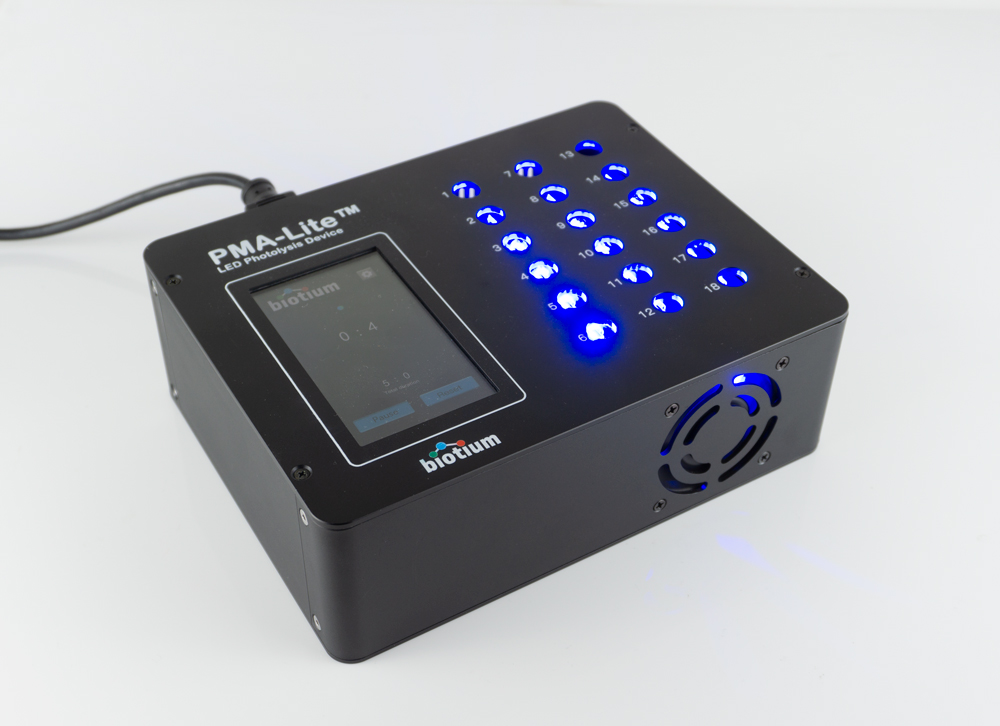PMA-Lite™ 2.0 LED Photolysis Device
An optimized photoactivation device designed for photolysis of PMAxx™- and PMA- treated samples in viability PCR.
Please fill in the inquiry form and we will contact you shortly.
Wishlist updated! View wishlist
Product Description
The PMA-Lite™ 2.0 LED Photolysis Device is a light-weight LED light box specifically designed for optimal photoactivation of samples treated with propidium monoazide (PMA), PMAxx™ or ethidium monoazide (EMA) in viability PCR applications.
Features
- Uniform and maximal illumination to 18 tubes
- Internal fan to maintain temperature ≤37°C
- Timer for 5-45 minutes of photoactivation
- Universal outlet adapter included for customers outside North America
- Two-year warranty from date of purchase
Specifications
- Dimensions (W x D x H): 8.66 x 6.69 x 3.27 in. (22 x 17 x 8.3 cm)
- Weight: 4.1 lb. 65.3 oz. (1.85 kg)
- Frequency Range: 50~60 Hz
- Power Range: 100~240 VAC
- Maximum Power: 60 W
- LED Output Wavelength: 465-475 nm
Controlled & Consistent Photoactivation
The PMA-Lite™ 2.0 LED Photolysis Device was developed to offer controlled and consistent photoactivation of viability PCR samples treated with PMA, PMAxx™, or other photoreactive dyes. The device holds up to 18 tubes and contains multiple LED lights that are positioned to provide uniform and maximal illumination to all tubes. The PMA-Lite™ 2.0 is designed as an improved version over the previous PMA-Lite™ LED Photolysis Device by including an intuitive touch screen for programming and monitoring, in addition to offering more flexibility for photoactivation durations.
Viability PCR for Rapid and Sensitive Analysis of Microbial Viability
Viability PCR (v-PCR) merges the specificity and sensitivity of qPCR-based methods with a dead cell selective DNA binding dye such as PMAxx™, PMA, or EMA. The technique is extremely versatile and can be applied to numerous species of bacteria, eukaryotes, viruses, and archaea.
PMAxx™ and PMA are photoreactive dyes developed by Biotium to have superior dead cell selectivity over culture-based methods and the alternative EMA v-PCR dye. The dyes form covalent crosslinks with dsDNA upon exposure to intense visible light. The mechanism that underlies the distinction of dead microbes from live ones is two-fold. The DNA that is crosslinked to the dye is not efficiently amplified, and it precipitates during DNA isolation, resulting in a lower recovery of modified DNA. Because the dyes are cell membrane impermeant, when a sample containing both live and dead bacteria is treated with dye, only dead bacteria with compromised cell membranes are susceptible to DNA modification. In a real-time PCR reaction, dead cell DNA will show delayed amplification and higher Ct than live cell DNA. v-PCR permits quantitation of bacterial viability and can be used with complex, mixed-strain, or viable but non-culturable samples.
To learn more about the advantages of determining microbial or cell viability using viability PCR, visit the Viability PCR Technology Page.
References
Download list of curated PMA and PMAxx™ References and a list of PMA and PMAxx™ Validated Bacterial Strains.


